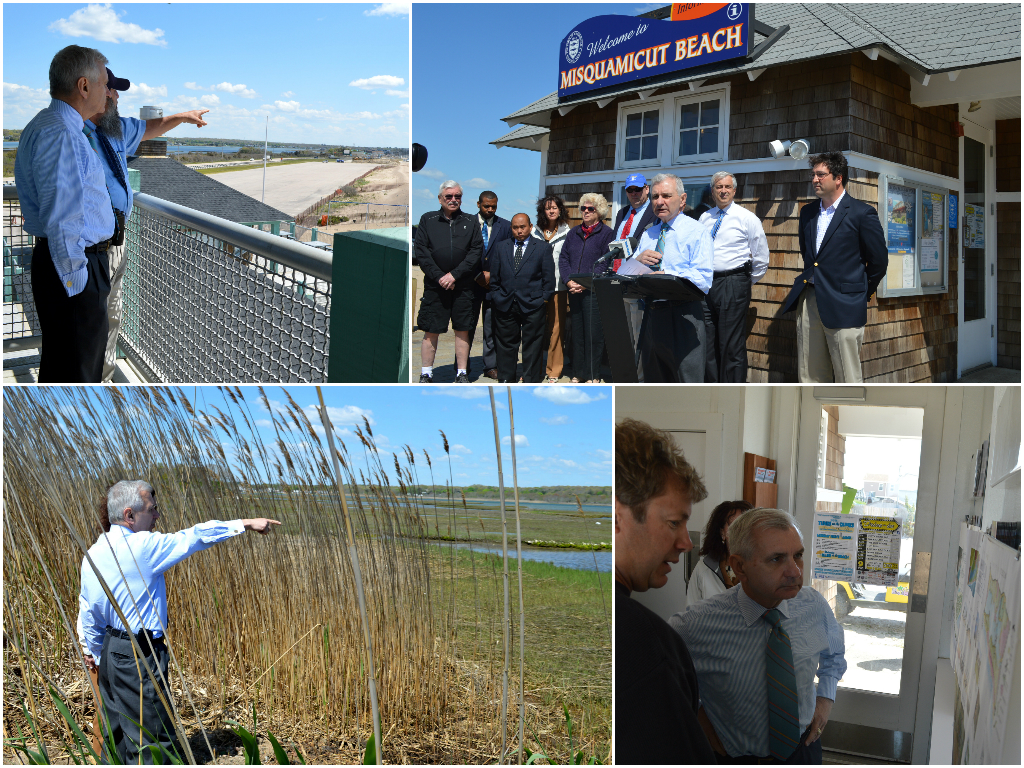Officials Announce $1 million to Help Dredge Winnapaug Pond & Revitalize Its Ecosystem

WESTERLY, RI – U.S. Senator Jack Reed today joined with officials from Westerly, the U.S. Department of Agriculture’s (USDA) Natural Resources Conservation Service (NRCS), and the Rhode Island Coastal Resources Management Council (CRMC) to announce over $1 million to help dredge Winnapaug Pond and revitalize its ecosystem. The NRCS project will help restore habitat and remove approximately 70,600 cubic yards of sediment that was deposited in Winnapaug Pond by Superstorm Sandy.
The federal funds -- which total $938,430 – include $780,000 in Emergency Watershed Protection (EWP) funding to support dredging and restoration efforts at Winnapaug Pond, as well as about $158,000 in technical assistance. The EWP funding requires a 25% match with non-federal dollars, so the total project cost is projected to be $1,042,700.00.
“Winnapaug Pond is a natural treasure and an important ecosystem. This is another positive step toward recovery from Sandy while preparing for future storms and sea-level rise,” said Reed. “Thanks to lot of hard work and coordination at the federal, state, and local levels, and with non-profit partners, we have an opportunity to cleanup, restore, and protect Winnapaug Pond and help make it more resilient. This effort is vital to Westerly’s recovery and maintaining a healthy environment and economy, one that enhances the state's ability to attract visitors and tourists to our shores.”
“Saltwater ponds like Winnapaug play an integral role in coastal ecosystems and help drive our economy,” said U.S. Senator Sheldon Whitehouse. “I am pleased to support this dredging project to help restore Winnapaug Pond’s natural habitat in the wake of Hurricane Sandy, and to support our coastal communities as they continue to recover.”
“Winnapaug Pond, a beautiful site along Westerly’s coast, suffered significant damage from Hurricane Sandy. These crucial funds will help restore the salt pond and strengthen it against future storms,” said Congressman Jim Langevin. “I am grateful to all of the local, state and federal partners who made this project possible, and I look forward to seeing Winnapaug and its ecosystem revitalized.”
The EWP project is being sponsored locally by the CRMC. Going forward, the USDA-NRCS and CRMC will be developing a plan to safely remove the sediment and restore the habitat of the Winnapaug Pond. The project is expected to kick-off next month.
The genesis of this plan began at a meeting Senators Reed and Whitehouse and Congressman Langevin arranged with the CRMC, Westerly, and the Army Corps of Engineers last year to discuss issues related to the restoration efforts around Westerly. As part of that conversation, Senator Reed brought in USDA-NRCS, which had funding from the Sandy Supplemental Appropriations bill and which had been a partner in recovery projects after the 2010 floods. Representatives from the USDA-NRCS worked with the offices of Senator Reed, Senator Whitehouse, Congressman Langevin and the Presidential Sandy Recovery Task Force and were able to identify the need for these additional resources.
“It takes a lot of effort and a variety of partners to develop and implement these kinds of projects. Some people might be surprised to see NRCS, an agency of the U.S. Department of Agriculture, involved in a coastal restoration and mitigation project like this, but NRCS has played an important role in disaster recovery and restoration projects in Rhode Island and throughout the country for years. It’s a tribute to the ingenuity of the people here to make that connection and to develop a project that works. Second, this is another demonstration of how federal, state, and local partners are continuing to work hard to help address the damage inflicted Sandy and to prepare for the next natural disaster we will face,” said Reed, the Chairman of the Appropriations Subcommittee on Interior & Environment.
The project is slated to use a process known as hydraulic dredging, which is cleaner and safer and creates less erosion than typical ‘drain and drag’ methods.
-end-